Atlantic Monthly Contributors's Blog, page 1096
April 8, 2013
Everyone Is on Board for This 'Crossfire' Reboot on One Condition...
Rumors have been swirling that CNN may revive Crossfire, the shuttered political debate show, since last Friday, and now it seems that most of the regular talking heads on the old Crossfire think it's a great idea so long as CNN doesn't make one fatal mistake.
Crossfire was a political debate show that ran from 1982 to 2005. The show would put two hosts, usually journalists or opinion columnists, and two guests, usually politicians or public policy experts, on opposite sides of a table and made them debate a single point for enough time to fill thirty minutes of television.
The Huffington Post's Michael Calderone tracked down a handful of former Crossfire co-hosts and, well, they all think bringing the show back is a pretty good idea. James Carville, a former co-host who recently left CNN, thinks it would be a "great" idea, pointing out that Crossfire wasn't always so bad. Niether side of the spectrum supported the Iraq war. "'Crossfire' never bought into the war drums on either side," he told Calderone.
On Friday, TV Newser's Alex Weprin reported CNN was looking to bring Crossfire back from the dead. The show was cancelled in 2005 only a few months after Daily Show host Jon Stewart famously sat down with Tucker Carlson, ripped the show to shreds, and said it was "hurting America." Then-CNN president Jonathan Klein agreed. "I agree wholeheartedly with Jon Stewart's overall premise," he told The New York Times' Bill Carter after the show was cancelled.
Other former hosts are fans of bringing the show back, but only under certain conditions. "I don’t think they should do it in front of a live audience," Pat Buchanan told Calderone. "People tend to play to it. It became less of the real back-and-forth, cross-examination." Bill Press was another former co-host who supports bringing the show back, but only if they bring back the "old" Crossfire. "It was the first political debate show on television, and it was by far the best and it was appointment television," Bill Press had previously told Politico's Patrick Gavin. In 2002, the show moved to a studio at George Washington University and was broadcast in front of a live studio audience. That's the Politico Press and Buchanan hate. They prefer the format of the original when it was shot with no audience and it was purely four people talking. The studio audience is really what killed the show, Press contends. "It was literally a gong show. They actually rang the bell and they had boxing gloves. They treated it as something amateurish and silly," he said.
Amazingly, this isn't the first time the idea of reviving the old Crossfire has come up. Last summer, Ramesh Ponnuru wrote in his Bloomberg View column that CNN should consider reviving the old school Crossfire to save political debate on cable. The older, simpler style of the original Crossfire could do it:
The one-subject rule made it impossible for the politicians to make it through the show on sound bites alone. That both hosts were journalists made for a fairer debate than the usual practice of today's political shows, which put journalists up against political operatives.
After Ponnuru's column came out, The Daily Caller's Matt Lewis, New York's Jonathan Chait, and Washington Examiner columnist Timothy Carney all came out in support of the idea. One notable detractor was the Washington Post's Ezra Klein, who argued that Crossfire's "left vs. right" format wouldn't elevate the discourse any more than other political talk shows.
But, before we get ahead of ourselves, CNN needs to confirm that it's actually bringing the show back. Klein, the president who cancelled the show, left the network a few years ago. Jeff Zucker is in the driver's seat now and his version of the networks wants to "reintroduce" itself. Does that mean bringing back Crossfire? Calderone said they're still debating it. Deadline's Dominic Patten reported last week that the show was definitively coming back in June, which seems sudden. Politico's Dylan Byers reported the show was "probably" coming back. Until then, we wait, but it seems like the first episode of the new Crossfire already has a good cast to debate whether or not bringing it back was a good idea.









Accidental Racists and More: A Field Guide to the Racists of America
Do you think racists are all the same? You are wrong. Country star Brad Paisley announced to the world on Monday that he is an "Accidental Racist" in a song that has earned lots of criticism. Before we unpack how one can be accidental about their racism (and why that exucse the racism), perhaps, in a way, he's onto something. While racism is pretty much just racism there are so many different species of racists.
 Accidental Racist. This is what Paisley claims to be. As the word accidental suggests, being a racist just sort of happened to him. The accidental racist is someone who doesn't think they're racist, but resents being called racists by others. That's what happened to Paisley, according to his song, when a Starbucks employee took his confederate flag T-shirt as a sign of support for white supremacy. Paisley thinks this is unfair because he doesn't think of the flag which once was banner of a generation that rebelled against the abolition of slavery and then rebelled against civil rights for black people (Georgia, for example, put the stars and bars on its state flag in 1956) as symbolizing racism. Through his protestations at being labeled as racist, the Accidental Racist acknowledges that racism exists (or at least existed) and that it is (or was) a bad thing, but by claiming to be the victim, he suggests that the real problem is all the people (black people, especially) who won't just let it go. (Also, Paisley can't really claim "I'm just a white man comin' to you from the Southland," as he says in the song, because he's from West Virginia, which is not the South.) There's also something vaguely deceptive about the Accidental Racist. There is no way Paisley was actually unaware that wearing the Confederate flag is a symbol of racism. He just does not believe it should be. A real accidental racist might be the Nathan Zuckerman character in Philip Roth's The Human Stain, in which the professor asks whether one of his students who's never attended his class is a "spook," not knowing the student is black.
Accidental Racist. This is what Paisley claims to be. As the word accidental suggests, being a racist just sort of happened to him. The accidental racist is someone who doesn't think they're racist, but resents being called racists by others. That's what happened to Paisley, according to his song, when a Starbucks employee took his confederate flag T-shirt as a sign of support for white supremacy. Paisley thinks this is unfair because he doesn't think of the flag which once was banner of a generation that rebelled against the abolition of slavery and then rebelled against civil rights for black people (Georgia, for example, put the stars and bars on its state flag in 1956) as symbolizing racism. Through his protestations at being labeled as racist, the Accidental Racist acknowledges that racism exists (or at least existed) and that it is (or was) a bad thing, but by claiming to be the victim, he suggests that the real problem is all the people (black people, especially) who won't just let it go. (Also, Paisley can't really claim "I'm just a white man comin' to you from the Southland," as he says in the song, because he's from West Virginia, which is not the South.) There's also something vaguely deceptive about the Accidental Racist. There is no way Paisley was actually unaware that wearing the Confederate flag is a symbol of racism. He just does not believe it should be. A real accidental racist might be the Nathan Zuckerman character in Philip Roth's The Human Stain, in which the professor asks whether one of his students who's never attended his class is a "spook," not knowing the student is black.
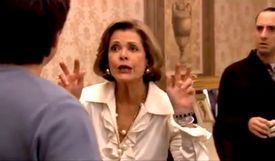 Casual Racist. What makes this kind of racist unique is that he or she doesn't do a nervous head turn to make sure no minorities are around before saying a racist thing. The Casual Racist thinks his or her racist comment is just a statement of practical fact. The tone of condescension — this form of racist is most associated with the caricatures of rich people — usually indicates that being racist is just the savvy way to be. A stand-out specimen is Arrested Development's Lucille Bluth, who in one episode says to a Spanish-speaking mover, "And that goes into storage right? Not into your apartment." Or like when then-Vice President George H.W. Bush referred to his Mexican-American grandchildren was "the little brown ones."
Casual Racist. What makes this kind of racist unique is that he or she doesn't do a nervous head turn to make sure no minorities are around before saying a racist thing. The Casual Racist thinks his or her racist comment is just a statement of practical fact. The tone of condescension — this form of racist is most associated with the caricatures of rich people — usually indicates that being racist is just the savvy way to be. A stand-out specimen is Arrested Development's Lucille Bluth, who in one episode says to a Spanish-speaking mover, "And that goes into storage right? Not into your apartment." Or like when then-Vice President George H.W. Bush referred to his Mexican-American grandchildren was "the little brown ones."
 Hipster Racist. Like the Accidental Racist, the Hipster Racist knows racism is wrong, but thinks that if it's wrapped up in enough layers of irony it can be cool inside joke. Last year, for example, when people noticed Girls had no real characters who weren't white, Girls writer Lesley Arfin tweeted about the well-received movie about a "What really bothered me most about Precious was that there was no representation of ME." Excavations of her writings showed other racist jokes, like an article section about defecating that began with, "That Which Shall Not Be Named: You know, 'dropping off the kids' or 'taking Obama to the White House.'" At Vice, Benjamin Leo defended Arfin, saying, "It’s 2012 and Obama’s in the White House: the McCarthyism 2.0 witch-hunting mob has been disarmed!" He was right that the country has changed, he was wrong that there's enough irony in the world to make racist jokes OK.
Hipster Racist. Like the Accidental Racist, the Hipster Racist knows racism is wrong, but thinks that if it's wrapped up in enough layers of irony it can be cool inside joke. Last year, for example, when people noticed Girls had no real characters who weren't white, Girls writer Lesley Arfin tweeted about the well-received movie about a "What really bothered me most about Precious was that there was no representation of ME." Excavations of her writings showed other racist jokes, like an article section about defecating that began with, "That Which Shall Not Be Named: You know, 'dropping off the kids' or 'taking Obama to the White House.'" At Vice, Benjamin Leo defended Arfin, saying, "It’s 2012 and Obama’s in the White House: the McCarthyism 2.0 witch-hunting mob has been disarmed!" He was right that the country has changed, he was wrong that there's enough irony in the world to make racist jokes OK.
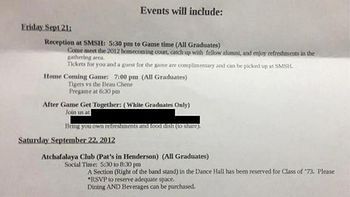 Unreconstructed Racist. This may be the nearest relation to the Hipster Racist in that these people choose to be racist, are aware that other people find that racism unacceptable, but think those poeple are wrong. As the name suggests, the Unreconstructed Racist is someone who has not changed with the times -- think Archie Bunker, Ellen Barkin's character in The New Normal, older relatives in white families. Last year, in a sign of belated but admirable progress, graduates of the St. Martinville, La., Senior High School Class of 1973 decided that for the first time in 40 years, they would not hold a segregated class reunion. Unfortunately, some thought that was too much change and a "whites graduates only" get together was held after the high school's Homecoming Game.
Unreconstructed Racist. This may be the nearest relation to the Hipster Racist in that these people choose to be racist, are aware that other people find that racism unacceptable, but think those poeple are wrong. As the name suggests, the Unreconstructed Racist is someone who has not changed with the times -- think Archie Bunker, Ellen Barkin's character in The New Normal, older relatives in white families. Last year, in a sign of belated but admirable progress, graduates of the St. Martinville, La., Senior High School Class of 1973 decided that for the first time in 40 years, they would not hold a segregated class reunion. Unfortunately, some thought that was too much change and a "whites graduates only" get together was held after the high school's Homecoming Game.
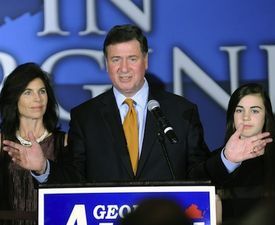 Unfortunate Racist. Like the Accidental Racist, these racists did not set out to be racist, and are pretty sure they are not racist, but somehow found themselves being racist anyway. The most typical example of this species are politicians who say something racist and then find it unfortunate when they realize it could kill their careers. Unfortunate Racists include former Virginia Sen. George Allen, who called an Indian-American "Macaca" in 2006. Allen responded to the resulting criticism by saying, "I do apologize if he's offended by that." There's also Alaska Rep. Don Young, who last month said his dad hired "50 or 60 wetbacks" to pick tomatoes in the olden days. Young apologized, saying, "I know that this term is not used in the same way nowadays, and I meant no disrespect... There was no malice in my heart or intent to offend; it was a poor choice of words." There's Hawaii state Rep. Faye Hanohano, who in February protested a lack of funding for Native Hawaiian artists by saying she didn't want art made by "Haoles, Japs, or Pakes." That means Caucasians, Japanese, or Chinese. She apologized, saying, "I'd like to express my sincere apology to any individuals or groups who may have been offended by my comments." While the Unfortunate Racist's apology may be motivated by self-preservation, unlike the Accidental, Unreconstructed, and Hipster Racists, he or she takes no pride in racism.
Unfortunate Racist. Like the Accidental Racist, these racists did not set out to be racist, and are pretty sure they are not racist, but somehow found themselves being racist anyway. The most typical example of this species are politicians who say something racist and then find it unfortunate when they realize it could kill their careers. Unfortunate Racists include former Virginia Sen. George Allen, who called an Indian-American "Macaca" in 2006. Allen responded to the resulting criticism by saying, "I do apologize if he's offended by that." There's also Alaska Rep. Don Young, who last month said his dad hired "50 or 60 wetbacks" to pick tomatoes in the olden days. Young apologized, saying, "I know that this term is not used in the same way nowadays, and I meant no disrespect... There was no malice in my heart or intent to offend; it was a poor choice of words." There's Hawaii state Rep. Faye Hanohano, who in February protested a lack of funding for Native Hawaiian artists by saying she didn't want art made by "Haoles, Japs, or Pakes." That means Caucasians, Japanese, or Chinese. She apologized, saying, "I'd like to express my sincere apology to any individuals or groups who may have been offended by my comments." While the Unfortunate Racist's apology may be motivated by self-preservation, unlike the Accidental, Unreconstructed, and Hipster Racists, he or she takes no pride in racism.









Obama's Last Weapon in the Fight for Gun Regulations: Emotion
President Obama, tired and clearly emotional, made another pitch for Congress to act on new gun restrictions Monday evening in Connecticut. His task was nearly impossible on its face: to translate the fury and urgency of the boisterous crowd in front of him into a wave that could sweep away opposition in Congress.

Speaking from Hartford, the president was introduced by Nicole Hockley, a mother of two sons who attended Sandy Hook Elementary. The younger was killed in the shooting on December 14. Her husband Dan by her side, Hockley explained how she and other advocates insisted on change in Connecticut's state capitol. They won, she insisted, with a combination of love and logic — the same combination that might convince Congress. "Do something before our tragedy becomes your tragedy," Hockley said.
The president came out to a huge ovation, responding to shouts of "I love you" with "I love you, too," as he usually does. But he clearly lacked the energy he showed on the campaign trail or during his 2011 call for action after the Giffords shooting. At times slightly slurring his speech, often stumbling over words, the president's demeanor was a strong reminder of his investment in the issue. Reminding the audience that he'd once said the massacre at Newtown was the worst day of his presidency, he indicated that a day on which new gun reforms failed would "be a tough day for me, too."
His case was simple. The new legislation in Connecticut was, as Hockley indicated, a result of passionate advocacy for change. Focusing heavily on the contentious issue of background checks, the president alternated between rational and emotional appeals. Ninety percent of Americans agree on expanded background checks, he reminded the audience, as he did in his last gun speech: "How often do 90 percent of Americans agree on anything? And yet, 90 percent of Americans agree on this." He pointed to support from law enforcement, NRA households, Republicans. "If our democracy is working the way it's supposed, and 90 precent of the people agree on something in the wake of a tragedy, you'd think that this would not be a heavy lift."
But it is a heavy lift, and Obama is clearly feeling the strain of lifting. At times he lashed out at his Republican opposition, railing against "political stunts" like a proposed filibuster of the gun package and insisting that the issue went beyond vote-counting in the Senate. "This is not about me. This is not about politics," he said. "This is about doing the right thing for all of the families who are here that have been torn apart by gun violence." What's more important, he asked Congress, "our children, or an A grade from the gun lobby?"
The most poignant moments came as Obama reminded the audience in Connecticut and watching from a distance of what was under consideration. It's often said, he noted, that some people are in the wrong place at the wrong time when they become victims of gun violence. But not always.
The kids at Sandy Hook were where they were supposed to be. So were those moviegoers in Aurora. So were those worshippers in Oak Creek. So was Gabby Giffords. She was at a supermarket, listening to the concerns of her constituents. They were exactly where they were supposed to be.
At one point the president got choked up, twisting his mouth to the side as he tried to retain his composure. Speaking of Nicole Hockley, he told the audience something that she'd told him — that her only hope was that her murdered son might still be able to visit her in her dreams. It was a powerful recollection, one to which the audience in the room in Connecticut visibly responded.
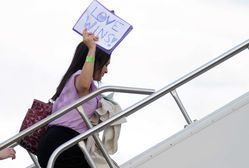 Some of the people in that room, families of victims of the Sandy Hook murders, joined the president on Air Force One as they traveled back to Washington to lobby members of Congress. It's an attempt to force his congressional opponents to feel for themselves the emotion that's obviously affecting him as the grinding political process moves forward.
Some of the people in that room, families of victims of the Sandy Hook murders, joined the president on Air Force One as they traveled back to Washington to lobby members of Congress. It's an attempt to force his congressional opponents to feel for themselves the emotion that's obviously affecting him as the grinding political process moves forward.
At least one of the president's opponents made his response public in the middle of Obama's speech.
In same moment Obama presses for action in CT MT @sahilkapur: McConnell will filibuster Reid's gun bill, according to spox @stewsays.
— jennifer bendery (@jbendery) April 8, 2013
Obama's remaining hope is that the Senate Minority Leader will at least be forced to explain that decision to Nicole Hockley in person.









Someone at the Vatican Is Downloading Really Dirty Porn
That whole secret report on gay sex and bribery and the Pope aside, the Catholic Church is known for being fairly uptight when it comes to doing the deed. So you might be surprised to learn that someone in the Vatican has a taste for leather. Sexy leather.
The file-sharing folks at TorrentFreak discovered that some Vatican City IP addresses were fairly frequent torrent users, downloading episodes of Chicago Fire, Touch, and The Americans. Someone in the Vatican also downloaded Love Actually, which isn't that surprising because it's a great movie, obviously, though we suspect they probably don't agree with some of the humor. But Bill Nighy's potty mouth is hardly the worst thing TorrentFreak has discovered in the download caches within the confines ofthe Catholic Church headquarters. There was porn, too. And lots of it.
While TorrentFreak declined to say what kind of porn some poor Vatican citizen was interested in, Fleshbot had no problem busting the Church's hidden freaks. [LINK IS VERY NSFW] "This Is The BDSM Porn They Watch In The Vatican," their headline reads. And, yeah, it's that simple. The files are for movies like TS Pussy Hunters, and Whipped Ass, and something called Russian Slaves. They sound... interesting. (As TorrentFreak suggests, "feel free to do your own 'research' using the titles shown above.")
Now, we can't say for certain if it's a cardinal or a priest or the Pope downloading these smutty things. Can you imagine the Pope — even the last one, though most of the IP addressed point to recent downloads — watching something called Whipped Ass? Well, no, don't answer that. Anyway, it could be one of the servants or a member of the Swiss Guard. We'll never know who it is, really. But someone in that small little town has some interesting taste. Kind of like that Velvet Mafia dossier that uncovered this: "the cardinals were said to have uncovered an underground gay network, whose members organise sexual meetings in several venues in Rome and Vatican City, leaving them prone to blackmail."
Well, this isn't blackmail, but speculate away!









How the British Papers Are Covering Thatcher's Death
Mourning for former British Prime Minister Margaret Thatcher wasn't entirely ceremonious. In fact, it was tempered with a reminder that a lot of people did not like her. So how are Britain's newspapers dealing with the news on their front pages? Collected and posted by the BBC's Nick Sutton, we see mix of respect and cynicism. The Sun, though leaning conservative, managed to find the populist tabloid angle.












Bonus: The Socialist Worker's radical take.
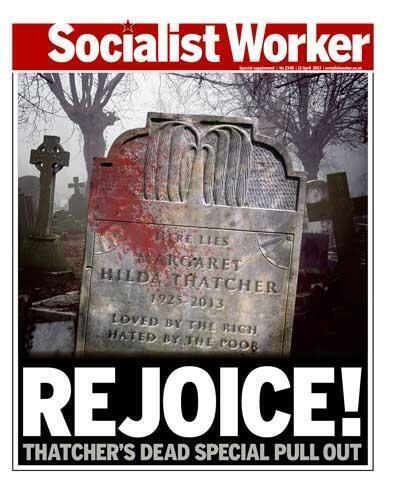









The Navy Has a Frickin' Drone-Shooting Laser
The U.S. Navy unveiled a laser capable of blasting away enemy drones Monday, and announced that it would likely be deployed on a real live U.S. naval ship some time early next year. The Office of Naval Research released this footage Monday of the Laser Weapon System (or LaWS for short) — footage in which the device actually shot down an unmanned aerial vehicle (the surveillance kind, the armed ones) during tests last summer. The weapon has advanced so much that the Navy plans to install one onto the U.S.S. Ponce sometime before its maiden voyage in the Middle East in early 2014. The Ponce was one of the Navy's oldest warships, but it's received an Extreme Naval Makeover into a state-of-the-art floating staging base.
The LaWS laser is powerful enough to take on "planes, drones and boats," according to NBC News. But it's obviously more complicated than that. The laser can only take out surveillance drones or "fast attack boats." As Wired's Spencer Ackerman points out, the laser does have it's limitations:
The fact that LaWS can kill a surveillance drone and a fast-attack boat has more to do with the vulnerabilities of those systems than it its own prowess. It cannot stop an anti-ship missile, and its beam, about the circumference of a dime, will do little more than singe a fighter jet. And there remain significant challenges with cooling a shipboard high-energy laser, a necessary safety feature.
The state of American warfare is cooler than you think. The Navy is expected to start development on lasers that would be powerful enough to take on warheads, or armored ships, or armored boats.
The main reason some military watchers are excited about the future of lasers is that they're so, well, cheap. According to Rear Adm. Matthew Klunder, the Navy's chief of research, it costs less to fire a laser than it would cost to buy a bag of Lays chips. "We're not talking about something that costs millions of dollars or multi-thousands of dollars," Klunder bragged to Ackerman. "We're talking something — and this is true data; remember, I'm a test pilot, so I deal in data, I don’t deal in PowerPoints, I deal in real performance data — we’re talking about a pulse of directed energy that costs under a U.S. dollar." Naval affairs specialist Ronald O'Rourke, in a report to Congress last month, was equally bullish about the low costs of lasers turning into a big part of the future of American weaponry: "Compared to existing ship self-defense systems, such as missiles and guns, lasers could provide Navy surface ships with a more cost effective means of countering certain surface, air, and ballistic missile targets," he wrote. Sequester? What sequester?









Is There a Secret Nutella Black Market?
For some (tasty) reason, thieves in the German town of Bad Hersfeld spirited away some 5.5 tons of the chocolate-hazelnut spread over the weekend. But if you can trick one of the top schools in the United States into paying $2,500 per week for Nutella, perhaps everyone should get in the chocolate topping business. "The gooey loot is worth an estimated 16,000 euros ($20,710)," reports the AP, detailing how, exactly, one walks into a trailer and runs away with some 11,000 pounds of flavored topping — if it's not an Ocean's 11-style inside job, that is. To put that in perspective, the two most popular Nutella jar sizes are 26.5 ounces and 13 ounces (1.6 lbs. or 0.8 pounds, respectively), meaning that the thieves might have had to walk/drive from the crime scene with about 6,875 units (of the big jars) or 13,750 jars (of the smaller size) in their back seat. (Yes, there are industrial sizes of Nutella, but that's neither here nor there.)
Second question: What do you do with that much Nutella? First off, if there's a major heist of 10,000 pounds of toast/waffles/bananas in the coming days, then that probably points to someone — or a group of people — with serious Nutella addictions. And there's always the story popping up that Nutella will get banned or taxed, which might scare people into hoarding the chocolate spread like a precious metal ... we guess?
But obviously, the important question here is whether or not there is, in fact, a black market for Nutella. MSN Money facetiously balked at the idea last month, but they did admit that Nutella thieves are primarily drawn to the allure of stealing chocolatey gooeyness because it's so expensive:
The problem is that Nutella is both tasty and somewhat costly. Even at discount chains like Wal-Mart, it fetches more than $6 per 26.5-ounce container, compared to $4 for a similar size container of Jif peanut butter. In France, citizens collectively flipped out when it was suggested that palm oil -- one of Nutella's key ingredients -- be taxed at 300%, according to France 24.
That report was based on a claim that Columbia University where the university was spending $5,000 per week because of students stealing the spread (the AP report does not say if the German heist is the work of Columbia kids). Columbia, to its credit, denied this stating that the figure was more like $2,500:
It is true that in the first 3-4 days after Nutella was recently added to the dining hall selections, demand was indeed extraordinarily high, with students enjoying a large amount in that initial short period. However, the actual cost was only about $2,500, and quickly went down to $450 per week for dining halls that serve some 3,600 students, seven days a week at three locations.
The smart kids at Columbia did the math, and still found out that number was too high — and that the university was still overpaying for its Nutella consumption to the tune of $6,000 more per month, and $43,200 more per year. Which could make cushy American colleges or students one of the prime targets for Nutella re-sale. Nutella dealers, we're totally onto you.









Margaret Thatcher's Trailblazing Career, in Photos
Margaret Thatcher was famous for using her girly persona to get tough things done — conservative economic policies, encouraging the fall of communism in Europe, war in the Falkland Islands, the first Gulf War. Thatcher died Monday at the age of 87. She had suffered from dementia, and stayed out of the public eye in recent years. But she remained the role model for female American politicians, even ones who had little in common with her — Hillary Clinton, Sarah Palin. Here are photos of her long career wearing feminine dresses and pouf hair and dominating rooms full of men.
1950: In her first political campaign, then-Margaret Roberts sang along with voters in the bar of the Bull Inn, Dartford, England during the 1950 general election. She lost.

1951: At age 26 with her soon-to-be-husband Denis Thatcher during the 1951 general election. She lost this one, too.
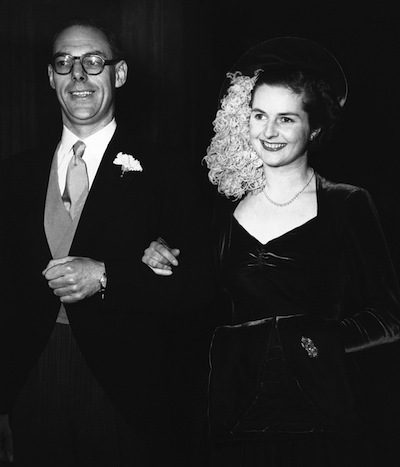
1975: Thatcher, then Opposition Leader, was visited in London by then-former California Gov. Ronald Reagan.

1976: Addressing the conservative party's annual conference.

1976: Visiting the British Rhine Army at Herford and Guetersloh, Germany, as opposition leader.

1977: Meeting President Jimmy Carter for the first time.

(Photo via MargaretThatcher.org.)
1977: At the White House with Carter.

(Photo via MargaretThatcher.org.)
1979: As the first female British prime minister, standing outside 10 Downing Street.

1979: A toast at the White House with Carter.

(Photo via MargaretThatcher.org.)
1981: Meeting Charlton Heston with Reagan at the White House.

(Photo via MargaretThatcher.org.)
1981: Thatcher, Reagan, and then-Vice President George H. W. Bush.

(Photo via MargaretThatcher.org.)
1982: Thatcher and Reagan speak with reporters.

1983: Visiting British soldiers of Y Company, 1st Battalion in Goose Green, Falkland Islands.

1984: At Camp David with Reagan.


(Photos via MargaretThatcher.org.)
1986: Nancy Reagan visits No. 10 Downing Street. She has interesting handwriting.

(Photo via MargaretThatcher.org.)
1986: In a tank while visiting British troops in Fallingbostel, West Germany.

1989: Thatcher "takes charge of proceedings," according to the Associated Press' caption, during a press event with Mikhail Gorbachev in London.

1989: Visiting President George H. W. Bush at Camp David.

(Photo via MargaretThatcher.org.)
1990: The Oval Office: then, as now, usually a room full of dudes. Thatcher told Bush not to "go wobbly" on Iraq.

(Photo via MargaretThatcher.org.)
1990: Flying a kite in Bermuda.

1991: With Reagan and a piece of the Berlin Wall at his presidential library in Simi Valley, California.

1995: After leaving office, Thatcher became a "geopolitical consultant" for the tobacco company Philip Morris for $250,000 a year. Here she arrives for her 70th birthday party, which reportedly cost Philip Morris $1 million.

2007: Commemorating the 25th anniversary of the Falkland Islands conflict with then-Prime Minister Tony Blair in London.

(Photos via Associated Press unless otherwise noted.)









Who is Don Draper's New Lover?
The big spoiler of last night's Mad Men premiere wasn't the gorgeous symbolism—that Chopin nocturne!—or really even the year in which the series picked up. On the pure, oh-my-God-that-happened level, the defining moment of the return came at the end, when Don fell into bed with Sylvia, the wife of his neighbor Dr. Arnold Rosen. But to fans of short-lived TV shows, he just wasn't sleeping with a Dante-loving housewife; he was sleeping with Lindsay Weir, the Army jacket-wearing mathlete heroine of the Judd Apatow-produced Freaks and Geeks.

Prepare yourself for some super weird fan fiction takes on this whole thing:
So wait, that was Linda Cardellini last night? Now I'm wondering if there's Lindsay Weir/Don Draper slashfic. #madmen #rule34
— Erin Fitzgerald (@gnomeloaf) April 8, 2013
Wait, if Linda Cardellini has a baby in the 1960s, does it grow up to be…Lindsay Weir?
— Dave Itzkoff (@ditzkoff) April 8, 2013
Who wants to write the one where the bus to the Grateful Dead concert—the one Lindsay jumps on in the last episode of Freaks and Geeks—actually transports her back to the 60s, wherein she, as Sylvia, attends one of their early concerts? Any takers?
Of course, Cardellini has had a career post-Freaks and Geeks. (And pre, she was on Boy Meets World.) The now 37-year-old actress had an unfortunate perm (in more ways than one) in Legally Blonde, then played Velma in Scooby-Doo, and she was on ER from 2003-2009. Recently, she starred in the indie Return. She won critical praise and an Independent Spirit Award nomination for her role as a soldier coming home form a tour of duty in the Middle East. The film also starred Roger Sterling (John Slattery) and Mona Sterling (Talia Balsam). (Slattery and Balsam are married in real life.)
But Lindsay is Cardellini's most iconic role, so her casting is drawing comparisons to season five guest star Rory Gilmore of Gilmore Girls, née Alexis Bledel. Bledel played a housewife who had an affair with Pete Campbell. (She and Vincent Kartheiser are now engaged in real life; Mad Men strife leads to real life lovel) Is Matthew Weiner a huge fan of television shows set in high school featuring strong female leads? We can only imagine both Lindsay and Rory rolling their eyes at Don and Pete's antics.
It looks like Cardellini doesn't have just a bit part. In a post-premiere interview with Entertainment Weekly, she explained that while she's worked with Slattery and Kartheiser in the past she said, "I wish I could tell you more stories, but then it would allude to who I hang out with on set. It would give away certain things that I probably can't." Does that mean Sylvia meets people in Don's life outside of Don and Megan? We can only hope she gets caught up with some proto-Daniel Desarios.









'Game of Thrones' Shows Us New Things
As a fan of the books, one of the constant worries of watching Game of Thrones is wondering what scenes the writers will have to cut out in order to meet the timing and narrative needs of series television. George R.R. Martin's sprawling novels are simply too big, too dense to perfectly transfer into a TV show. So, we wonder, which favorite characters will be omitted? What beloved scenes or particular narrative arcs will be tossed out or condensed for expedience's sake? So far a few of those cuts have rankled a bit, but amidst all that fretting, it's easy to forget the positive effects of the page to screen translation. The television show has also added some wonderful things to this knotty tale.
Last season we got some, ahem, interesting scenes between Renly and Loras that are only ever barely hinted at in the books. So, ten points to the TV show for that. And of course there's also been the expansion of Robb's presence, who is never a point-of-view character in the books but is so integral to the larger story. And, perhaps most satisfyingly of all, we got to spend some grand time with Tywin Lannister, also never a POV character in the novels but, like Robb, of major significance to the plot. The conventions of television insist that we get to know these people up-close and in-person if they are to truly matter to the story, and so here they are on the show, played richly by good actors and given the shading they are oftentimes lacking in the books.
So too for this season. The writers are wisely letting us get to know certain characters, and showing us certain scenes only mentioned in the books, so the viewer can get a full grasp of the dramatic stakes. I've so far loved everything with Margaery Tyrell, an important but largely background character in the books who has been beautifully fleshed-out by Natalie Dormer. The culmination of the Tyrell storyline has not yet been reached in the novels, but we at least know one major affect they have on the larger story, so it's good to see that the family is being prominently featured on screen. Last night's tricky little scene between Joffrey and Margaery was delightful, showing us Margaery's political acumen and giving us yet another reason to loathe young Joffrey and his unsettling proclivities. While his sadistic side was perhaps a bit overstated in the first season, this scene was pitched just right, the tone perfectly menacing without being over-the-top.
I also enjoyed Lady Catelyn's rueful monologue to Robb's wife Talisa; it didn't necessarily do anything for plot mechanics, but it was a nice juicy bit of dramatic storytelling nonetheless. The show's writers know that they have to condense hundreds and hundreds of pages of exposition, both narrative and emotional, into ten hours of television every year, and scenes like Cateyln's last night do a nicely compact job of doing that, while also giving an actress like Michelle Fairley a chance to shine. Of course I likely won't be happy with every addition (or omission), but on the whole the show consistently feels in remarkably capable and confident hands. It stands sturdily as its own entity, while both satisfying and surprising the series' loyal readers. Well, this reader, at least.









Atlantic Monthly Contributors's Blog
- Atlantic Monthly Contributors's profile
- 1 follower



